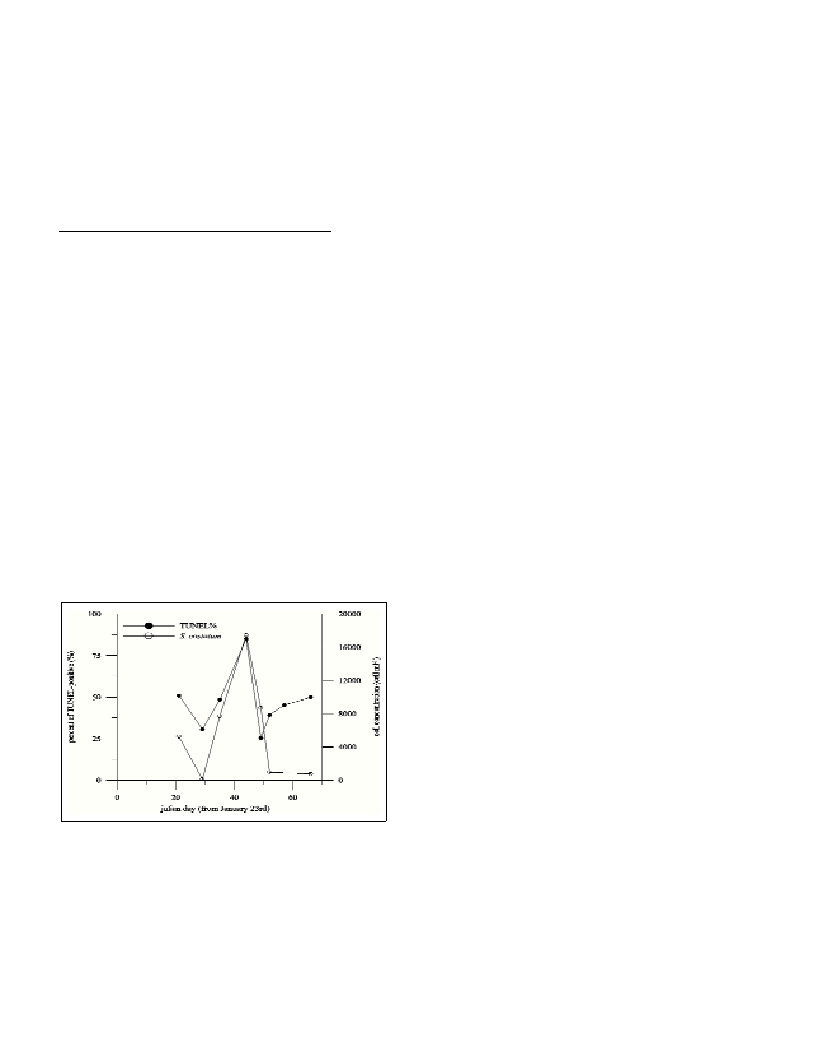APOPTOSIS AND CELL LYSIS RATES DURING A DIATOM BLOOM IN THE NORTH ADRIATIC SEA
Casotti R.
1*
, Brunet C.
1
, Bastianini M.
2
, D’Ortenzio F.
1
, Mazza S.
1
, Ianora A.
1
, Miralto A.
1
1
Stazione Zoologica “A. Dohrn” di Napoli, Italy - * raffa@szn.it
2
Istituto di Scienze Marine, CNR, Venezia, Italy
Abstract
During the late winter diatom bloom in the Northern Adriatic Sea in 2002, the proportion of apoptotic cells were estimated using the
TUNEL assay, and cell lysis rates using the FDA method. Apoptotic cells were more abundant (up to 85%) at the peak phase of the bloom,
when also cell lysis rates increased (up to 0.8 d
-1
), indicating that phytoplankton was experiencing physiological stress conditions. The
occurrence of apoptotic cells may indicate an endogenous control of diatom abundances when nutrients are close to depletion, possibly
triggered by chemical signaling within the population.
Keywords: diatoms, bloom, apoptosis, fronts, Adriatic
Rapp. Comm. int. Mer Médit., 37,2004
329
In February-March 2002, six stations were sampled on a weekly
basis to estimate phytoplankton cell concentrations along a coast-to-
offshore transect in correspondence to the Po river delta.
Phytoplankton concentrations were estimated using ?ow cytometry,
microscopy, HPLC-pigment analysis, and remote sensing (SeaWifs).
Percentages of apoptotic cells were estimated using the TUNEL assay,
while cell lysis rates were estimated using the FDA method.
Pigment indicators (Dt/Dt+Dd) suggested a light-induced stress on
phytoplankton trapped within the front separating Po river freshwater
from offshore marine waters.
The evolution of total phytoplankton concentrations was evident
only at the three most offshore stations, situated on the external side
of an haline front, caused by the freshwater river out?ow. Cell
concentrations ranged from 500 cell ml
-1
before the bloom to 10
5
cell
ml
-1
at its peak (20 March). The phytoplankton bloomwas mainly
composed of diatoms (up to 90% of total counts), with Skeletonema
costatumdominating the diatoms at the peak phase of the bloom.
At the frontal area (station 4) high percentages of Diatoxanthin and
Diadinoxanthin were observed, indicating the occurrence of light-
induced stress within the phytoplankton population trapped within the
haline front.
Within the S. costatumpopulation, apoptotic cells ranged from 30
to 85% of total cells at all stations, and at station 4 their evolution
strongly correlated with S. costatumcell numbers (Fig. 1). The peak
in apoptotic cells corresponded to a peak in cell lysis rates (from 0.1
to 0.8 d
-1
).
Fig. 1. S. costatumcell concentrations (cell ml-
1
, closed symbols) and
percentages of TUNEL-positive cells (open symbols) in the northern
Adriatic Sea in February-March 2002.
The high percentage of apoptotic cells may indicate an
endogenously-controlled process of initiation of lysis of
phytoplankton cells.
Apoptosis is the phenotype of Programmed Cell Death, an active
mechanism of cell disruption activated by cells as a response to stress
or changes in environmental factors.
The presence of apoptosis in unicellular organisms may represent
an evolutionary relic, but also support the hypothesis that it is a
widespread and crucial feature of the eukaryote world, best suited for
adaptation to different environments, and, as in our case, as a reaction
to unfavorable conditions.
The late winter diatom bloom is a recurrent feature in the North
Adriatic Sea, starting in February and persisting in a large area for
more than two months. With respect to other coastal areas, this bloom
is characterized by the dominance of Skeletonema costatum, which is
later on replaced by Chaetoceros species, during the following spring
bloom. No detailed information is available on the dynamics of this
bloom, which is peculiar for its duration and almost monospecificity.
Miralto et al.(1) have shown that the North Adriatic late winter
diatom bloom has a strong effect on copepod reproduction and
therefore recruitment, strongly impacting the whole food web. This
effect has been attributed to the production of unsaturated aldehydes
by diatom species. These molecules appear to be involved in a defence
mechanism activated after cell membrane disruption, as during
grazing (2). It is reasonable to expect that aldehydes are also released
in the seawater following cell lysis, a common process at sea,
controlled by exogenous (bacteria, viral attack, nutrient limitation), or
endogenous (senescence, automortality) factors (3; 4). Algal
aldehydes have been shown to be toxic to other phytoplankton and to
induce apoptosis in Copepods and sea urchin embryos (5). Possibly,
the realease of such compounds via natural lysis of cells during the
bloom may have determined apoptosis of cells during the late winter
bloom of 2002. Apoptosis may therefore be regarded as a general
mechanism acting at sea to control population growth, in order to
optimize resources utilization at the end of the bloom.
References
1-Miralto A., Barone G., Romano G., Poulet S.A., Ianora A., Russo G.L.,
Buttino I., Mazzarella G., Laabir M., Cabrini M., Giacobbe M.G., 1999.
The insidious effect of diatoms on copepod reproduction. Nature, 402:
173-176.
2-Pohnert G., 2000. Wound-activated chemical defense in unicellular
planktonic algae. Angew. Chem. Int. Ed Engl.,39: 4352-4354.
3-Agustí S., Satta M.P., Mura M.P., Benavent E., 1998. Dissolved
esterase activity as a tracer of phytoplankton lysis: Evidence of high
phytoplankton lysis rates in the northwestern Mediterranean. Limnol.
Oceanogr.,43(8): 1836-1849.
4-Veldhuis M.J.W., Kraay G.W., Timmermans K.R., 2001. Cell death in
phytoplankton: correlation between changes in membrane permeability,
photosynthetic activity, pigmentation and growth. Eur. J. Phycol.,36: 167-
177.
5-Romano G., Russo G.L., Buttino I., Ianora A., Miralto A., 2003. A
marine diatom-derived aldehyde induces apoptosis in copepod and sea
urchin embryos. J. Exp. Biol.,206: 3487-3494.

